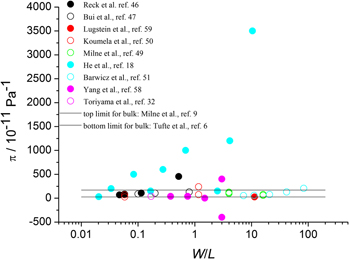Crossref Citations
This article has been cited by the following publications. This list is generated based on data provided by
Crossref.
Araki, Wakako
Takemura, Yu
Arai, Yoshio
and
Malzbender, Jürgen
2014.
Electrical Conductivity of Ba0.5Sr0.5Co0.8Fe0.2O3−δunder Uniaxial Compression at Elevated Temperatures.
Journal of The Electrochemical Society,
Vol. 161,
Issue. 11,
p.
F3001.
Jang, Houk
Kim, Jaeseok
Kim, Min-Seok
Cho, Jeong Ho
Choi, Hyunyong
and
Ahn, Jong-Hyun
2014.
Observation of the Inverse Giant Piezoresistance Effect in Silicon Nanomembranes Probed by Ultrafast Terahertz Spectroscopy.
Nano Letters,
Vol. 14,
Issue. 12,
p.
6942.
McClarty, Megan M.
Bruce, Jared P.
Freund, Michael S.
and
Oliver, Derek R.
2015.
Piezoresistive characterization of bottom-up, n-type silicon microwires undergoing bend deformation.
Applied Physics Letters,
Vol. 106,
Issue. 2,
Zhang, Songsong
Yen, Shih-Cheng
Xiang, Zhuolin
Liao, Lun-De
Kwong, Dim-Lee
and
Lee, Chengkuo
2015.
Development of Silicon Probe With Acute Study on <italic>In Vivo</italic> Neural Recording and Implantation Behavior Monitored by Integrated Si-Nanowire Strain Sensors.
Journal of Microelectromechanical Systems,
Vol. 24,
Issue. 5,
p.
1303.
Zhu, Yong
and
Chang, Tzu-Hsuan
2015.
A review of microelectromechanical systems for nanoscale mechanical characterization.
Journal of Micromechanics and Microengineering,
Vol. 25,
Issue. 9,
p.
093001.
Phan, Hoang-Phuong
Dao, Dzung Viet
Nakamura, Koichi
Dimitrijev, Sima
and
Nguyen, Nam-Trung
2015.
The Piezoresistive Effect of SiC for MEMS Sensors at High Temperatures: A Review.
Journal of Microelectromechanical Systems,
Vol. 24,
Issue. 6,
p.
1663.
Phan, Hoang-Phuong
Kozeki, Takahiro
Dinh, Toan
Fujii, Tatsuya
Qamar, Afzaal
Zhu, Yong
Namazu, Takahiro
Nguyen, Nam-Trung
and
Dao, Dzung Viet
2015.
Piezoresistive effect of p-type silicon nanowires fabricated by a top-down process using FIB implantation and wet etching.
RSC Advances,
Vol. 5,
Issue. 100,
p.
82121.
Bosseboeuf, Alain
Etienne Allain, Pierre
Parrain, Fabien
Le Roux, Xavier
Isac, Nathalie
Jacob, Serge
Poizat, Alexis
Coste, Philippe
Maaroufi, Seiffedine
and
Walther, Arnaud
2015.
Thermal and electromechanical characterization of top-down fabricated p-type silicon nanowires.
Advances in Natural Sciences: Nanoscience and Nanotechnology,
Vol. 6,
Issue. 2,
p.
025001.
Huang, Zhijun
Huang, Yifeng
Pan, Zhangxu
She, Juncong
Deng, Shaozhi
Chen, Jun
and
Xu, Ningsheng
2016.
Self-modulated field electron emitter: Gated device of integrated Si tip-on-nano-channel.
Applied Physics Letters,
Vol. 109,
Issue. 23,
Pandya, Hardik J.
Park, Kihan
Chen, Wenjin
Goodell, Lauri A.
Foran, David J.
and
Desai, Jaydev P.
2016.
Toward a Portable Cancer Diagnostic Tool Using a Disposable MEMS-Based Biochip.
IEEE Transactions on Biomedical Engineering,
Vol. 63,
Issue. 7,
p.
1347.
Phan, Hoang-Phuong
Dinh, Toan
Kozeki, Takahiro
Nguyen, Tuan-Khoa
Qamar, Afzaal
Namazu, Takahiro
Nguyen, Nam-Trung
and
Dao, Dzung Viet
2016.
Nano strain-amplifier: Making ultra-sensitive piezoresistance in nanowires possible without the need of quantum and surface charge effects.
Applied Physics Letters,
Vol. 109,
Issue. 12,
Dao, Dzung Viet
Phan, Hoang-Phuong
Qamar, Afzaal
and
Dinh, Toan
2016.
Piezoresistive effect of p-type single crystalline 3C–SiC on (111) plane.
RSC Advances,
Vol. 6,
Issue. 26,
p.
21302.
Cheng, Baochang
Xiong, Li
Cai, Qiangsheng
Shi, Haiping
Zhao, Jie
Su, Xiaohui
Xiao, Yanhe
and
Lei, Shuijin
2016.
Enhanced Giant Piezoresistance Performance of Sandwiched ZnS/Si/SiO2 Radial Heterostructure Nanotubes for Nonvolatile Stress Memory with Repeatable Writing and Erasing.
ACS Applied Materials & Interfaces,
Vol. 8,
Issue. 50,
p.
34648.
Zhang, Jiahong
Zhao, Yang
Ge, Yixian
Li, Min
Yang, Lijuan
and
Mao, Xiaoli
2016.
Design Optimization and Fabrication of High-Sensitivity SOI Pressure Sensors with High Signal-to-Noise Ratios Based on Silicon Nanowire Piezoresistors.
Micromachines,
Vol. 7,
Issue. 10,
p.
187.
Phan, Hoang-Phuong
Dinh, Toan
Kozeki, Takahiro
Qamar, Afzaal
Namazu, Takahiro
Dimitrijev, Sima
Nguyen, Nam-Trung
and
Dao, Dzung Viet
2016.
Piezoresistive effect in p-type 3C-SiC at high temperatures characterized using Joule heating.
Scientific Reports,
Vol. 6,
Issue. 1,
McClarty, M. M.
Jegenyes, N.
Gaudet, M.
Toccafondi, C.
Ossikovski, R.
Vaurette, F.
Arscott, S.
and
Rowe, A. C. H.
2016.
Geometric and chemical components of the giant piezoresistance in silicon nanowires.
Applied Physics Letters,
Vol. 109,
Issue. 2,
Phan, Hoang-Phuong
2017.
Piezoresistive Effect of p-Type Single Crystalline 3C-SiC.
p.
31.
Zhang, Songsong
Lou, Liang
and
Gu, Yuandong Alex
2017.
Development of Silicon Nanowire-Based NEMS Absolute Pressure Sensor Through Surface Micromachining.
IEEE Electron Device Letters,
Vol. 38,
Issue. 5,
p.
653.
Phan, Hoang-Phuong
2017.
Piezoresistive Effect of p-Type Single Crystalline 3C-SiC.
p.
1.
Puyoo, E.
Malhaire, C.
Thomas, D.
Rafaël, R.
R'Mili, M.
Malchère, A.
Roiban, L.
Koneti, S.
Bugnet, M.
Sabac, A.
and
Le Berre, M.
2017.
Metallic nanoparticle-based strain sensors elaborated by atomic layer deposition.
Applied Physics Letters,
Vol. 110,
Issue. 12,


